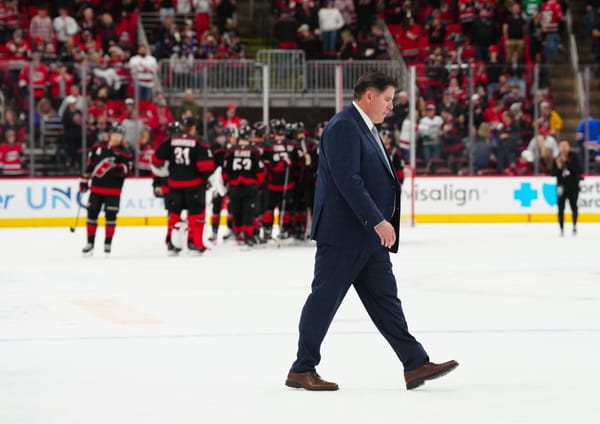Rick Nash Trade: Analyzing the Rangers’ Acquisitions From Boston
The McDonagh/Miller trade to Tampa Bay was so shocking and massive that Nash’s trade to Boston almost seems like an afterthought. But it’s not! This was still one of the biggest moves of the trading deadline, and it has considerable implications on what the Rangers will look like going forward. The Rangers acquired four pieces from the Bruins in return for Nash. Here is an in-depth look at what each brings the Rangers.
Ryan Lindgren
The Minnesota native was drafted by the Bruins with the 49th overall pick in the 2016 draft. He’s represented the United States at the World Junior Championships twice, winning gold in 2017 and bronze in 2018. Currently, he is enrolled as a sophomore at the University of Minnesota, where he was a teammate of Vinni Lettieri in 2016-2017.
Like the other defensemen the Rangers have acquired in recent days - O’Gara, Rykov, and Hajek - Lindgren is a shutdown defenseman. Where he differs from the pack is in his physicality. The aforementioned defensemen play with some grit themselves, but Lindgren takes it to a whole different level. Seriously, just watch this small sample of examples I gathered, and make sure to stay for the grand finale at towards the of the video (he’s wearing #5 in each clip).
He’s only 6’0, but at nearly 200 pounds he’s incredibly strong. He’s also That Guy; the one every player on the opposing team hates. The hits speak for themselves. He’s also the first guy in every post-whistle scrum and the other usual shenanigans. He talks a big game and he gets under players’ skin. There’s a fine line between that being an asset and a burden. He took way too many penalties during his freshman season, though he’s improved in that department. Most importantly, he has refrained from making any particularly dangerous hits. He does a good job of being a nuisance and taking some liberties without overtly crossing the line.
The Rangers also love his personality. It is clear that adding some Type-A personalities is a priority for the Rangers. He has been a captain for USA hockey at multiple levels, and is an alternate captain for Minnesota as a sophomore.
The problem with Lindgren is a complete lack of offensive production. Yes, he is a shutdown defenseman, and it’s not his job to be a point producer. Even so, most shutdown defensemen in the NHL produced some degree of offense at lower levels. Brian Dumoulin, for instance, put up 30 assists in 33 games as a sophomore with Boston College. Ben Hutton had 29 points in 35 games as a sophomore for Maine.
At the time of the 2016 draft, Canucks Army’s pGPS model found that only 6.67% of players with similar size and offensive production successfully made it to the NHL. Since then, the offense hasn’t particularly improved. He had one goal and 6 assists in 32 games as a freshman and has two goals and five assists in 33 games this season.
There are a few reasons for optimism that Lindgren can beat the odds, though. First, Minnesota head coach Don Lucia does not particularly encourage his shutdown defensemen to get involved in the offensive side of the game. Under Lucia, Brady Skjei very often got rid of the puck before center ice and didn’t often join rushes or try to make plays in the offensive zone. Once he turned pro, the restraints were removed, and he showed more offensive ability than he ever let on in college.
The other reason for optimism is Lindgren’s skating ability. Typically, “shutdown defensemen” who don’t produce points are the usual slow, clumsy players who belong in 1988. They become exposed as glorified tree stumps in the NHL. Lindgren, though, is a great skater. He seals gaps quickly and can keep up with the fastest wingers. In theory, the right coaches could work with him on joining the rush.
Lindgren’s upside is limited due to the lack of offense, but he is an interesting combination of speed, strength, and personality. If the right buttons are pushed, he could turn into a character #4-#6 defenseman.
2018 First-Round Pick
As one would have expected, the Rangers received a first-round pick as part of the Nash trade. The Bruins currently rank 4th in the NHL by points percentage, which translates to the 28th-overall selection in the draft. That will change depending on where the Bruins finish in the regular season, and there are also multiple playoff outcomes that will determine where in the draft this pick will land. Most likely, it will be in the 26-31 region. It will be a chance to grab a good prospect with a plausible chance of turning into an impact player.
Matt Beleskey (50% Cap Hit Retained by Boston)
Beleskey was a necessarily contract dump from Boston to make the trade abide by the salary cap. He’s a clearcut example of why it’s so dangerous to pay a premium price for a player with an unsustainably high shooting percentage. After scoring 35 goals in his first 264 NHL games, Beleskey doubled his shooting percentage in 2014-2015 with the Ducks and scored 22 goals in 64 games, plus 8 in 16 playoff games. Boston signed him to a long-term contract the following summer, and his shooting percentage regressed. He did okay in his first season with Boston, scoring 15 times, but has since produced just 3 goals in his last 63 games. Boston waived him and sent him to the AHL, where he has continued to struggle.
Again, taking Beleskey was simply a necessary aspect of the trade in order to make it happen. However, maybe he can turn into an asset for the Rangers. Fluke year aside, Beleskey was a solid bottom-six forward with secondary scoring ability. It’s a safe bet that Beleskey’s struggles now are as much mental as they are physical. Maybe a change of scenery gets him going. If not, it’s little harm to the Rangers. With Boston eating half of his cap hit, and the Rangers stashing him in Hartford, he will cost only $825K against the cap next season before becoming a free agent in 2019.
Ryan Spooner
This is where the trade goes from run-of-the-mill rental deal to an extremely interesting one for the Rangers. Spooner was a necessary sacrifice from Boston in order to make the trade work financially. Unlike Beleskey, Spooner is undoubtedly a relatively sizable asset. The 26-year-old forward can play both center and wing, and has averaged 46 points per 82 games over his NHL career. This season, he has 27 points in 40 games. That includes two assists from his debut as a Ranger last Sunday.
In some ways, Spooner fills the hole the JT Miller leaves behind. Like Miller, Spooner is a crafty forward who is tremendous at carrying the puck through the neutral zone and creating plays in the offensive zone. His ability is a bit less due to his smaller size and lesser scoring ability, but he dishes out some great passes in the offensive zone.
Is Spooner part of the Rangers’ long-term plans, though? It’s unclear at this point. Immediately following the Rangers’ acquisition of him, TSN put Spooner on their trade bait list. Spooner is a restricted free agent this summer and has the ability to force arbitration. He is 26 and is set to be an unrestricted free agent in 2019. Though he can play wing, he is primarily a center, which is a position in which the Rangers now find themselves neck deep. If he and the Rangers are mutually interested, there could be a multi-year contract to sign. If not, the Rangers could get a quality return on him in the trade market.
Verdict
Knowing what we do now, the Rangers were incredibly smart to trade Nash in advance of the trading deadline. Once he was moved, the trade market for rental wingers collapsed. Returns for Evander Kane, Patrick Maroon, and Thomas Vanek were extremely underwhelming. had the Rangers waited longer, they too could have been one of the teams scrambling to make an underwhelming trade for the sake of saving face. Taking on a bad contract, though maybe happenstance, was a great move which allowed the Rangers to acquire more with negligible hockey-related consequences.
Related Articles:
McDonagh & Miller Trade: Analyzing the Trade Package from the Lightning
Grabner Trade: Analyzing the Rangers’ Return from the Devils




